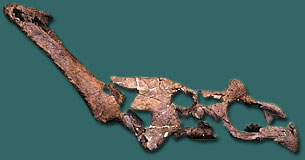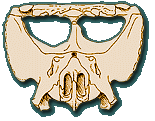Chasmosaurus irvinensis
Amazing Story!
|
Did you ever make a mistake, only to have things turn out really well, maybe even better than you had planned? That's what happened to Canadian Museum of Nature researchers when they opened a plaster field jacket only to discover they had found a new dinosaur, previously unknown to science!
Palaeontologists have debated for years about the legs of ceratopsian (horned) dinosaurs: some think that their front legs were straight, like an elephant's, and some think that their legs bent outwards at the knees, like a turtle's. Former Museum palaeontologist Wann Langston had an idea: why not examine the legs of a dinosaur that had died standing up, to see whether this would resolve the debate? He knew that he had collected such a specimen in 1958, a ceratopsian he thought was likely a Chasmosaurus belli. |

3D Dino Movies!
See the dinosaur Chasmosaurus irvinensis brought to life, manipulate 3D models of it, and see the 3D scanning process in action! |
|

The skull of the holotype of Chasmosaurus irvinensis.
Catalogue: CMNFV41357
|
But field jackets aren't exactly stamped "This End Up". They're lumpy, irregularly shaped things, with no clues as to which end might be the head and which the tail. When Nature's staff opened the field jacket, intending to start at the bottom (to get to the legs first), they found that they had opened the top, and were excavating the frill instead! And lo-and-behold, the frill was different-enough from previously known chasmosaurs to suggest that this one might be a species previously unknown to science!
The skull (including the frill) of this new chasmosaur specimen is about 1.4 m long. At its widest, the frill is 1 m. The animal was probably 3 m long from the tip of its snout to its hip, with its tail adding another 2 m. There is no way to know if the animal was male or female.
|
Lead researcher Rob Holmes doesn't know whether this dinosaur will add anything useful to the front legs debate, but he doesn't seem to mind. The whole Museum team (Rob Holmes, Clayton Kennedy and Kieran Shepherd) is excited to have discovered a new horned dinosaur, right in Nature's collection. The first task for the research team was to carefully reconstruct the skull; palaeontologists often use the skull to identify a dinosaur. Careful measurements were taken and a phylogenetic analysis was completed. (This analysis constructs a type of family tree in order to compare similarities and differences with known dinosaurs). The result led in October 2001 to the identification of the new species, with its own unique name: Chasmosaurus irvinensis.
|

The distinct curl is obvious in this detail of epoccipitals on the Chasmosaurus irvinensis frill.
|
|

In this illustration of an anterior view of the Chasmosaurus irvinensis skull, the "chasms" are clearly visible. |
Palaeontologists had described most known horned dinosaurs by the beginning of the First World War, and few species have been discovered in recent years; sometimes it pays to open the wrong end first! |
|


